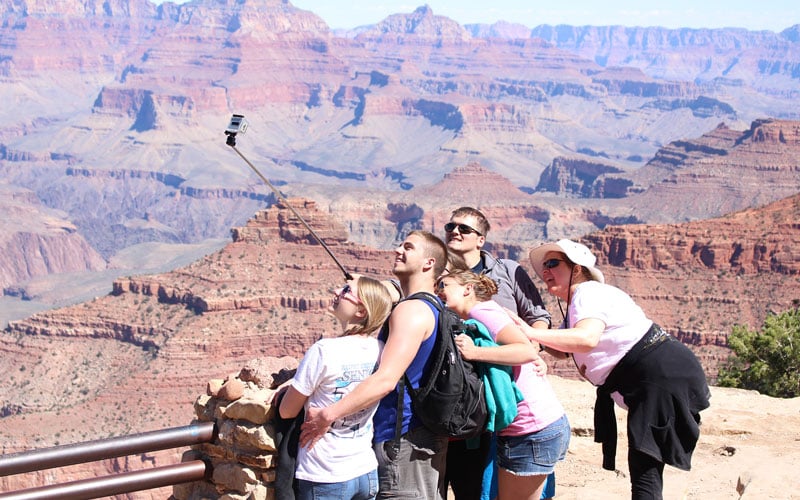
Some environmental groups worry that a National Park Service push to increase visitors – like these tourists at Grand Canyon National Park – in its centennial year will harm parks, but Park Service officials say they are keenly aware of the need to balance conservation and tourism. (Photo by Sophia Kunthara/Cronkite News)
WASHINGTON – The National Park Service hopes to boost visits in honor of its centennial later this month, but its “Find Your Park” program has some environmental groups asking: How much is too much?
“The Park Service’s current posture seems to be that there can’t be enough visitation,” said Jeff Ruch, executive director of Public Employees for Environmental Responsibility. “We don’t think that this (overcrowding) is a peripheral issue.”
Ruch said crowds at the Grand Canyon are a particular concern, but that most parks are facing the same challenges.
“The Grand Canyon is not alone because I think the Park Service has become intoxicated with setting visitor records,” he said. “Self-celebration has blocked out room for introspection and planning.”
But officials with both the Park Service and the Grand Canyon said they are well aware of the dangers of overcrowding at parks and have taken steps to balance the need to preserve nature against the need to present nature to as many visitors as possible.
Grand Canyon officials said they have worked toward practices that can help prevent the damage Ruch is worried about, and have even established visitor limits in some areas around the Colorado River.
Kirby-Lynn Shedlowski, the park’s public affairs officer, said the focus at the Grand Canyon has been on educating visitors on how to protect the nature within the park.
She said staffers are trained to talk with visitors during orientation and in the field about how to protect the park’s resources. That includes everything from telling visitors where to find trash cans to encouraging them to report any person they see taking objects or doing anything else to harm the nature within the Grand Canyon.
“I think the thing that is really important as the Park Service enters its second century is educating people … to make sure these things are here for the next century,” Shedlowski said. “I think as long as we’re educating people and making sure that people are able to recreate, we’re achieving our mission.”
National Park Service spokesman Tom Crosson acknowledges that overcrowding can pose a threat, but it is one that has to be dealt with by individual parks, not by headquarters in Washington.
“It’s so different,” Crosson said. “There’s no one thing that the Park Service here in D.C. can tell all parks.”
He said that 500 people “would overwhelm the Liberty Bell, but that’s a drop in the bucket for the Grand Canyon.”
Shedlowski said that park officials are trying to “make little changes in how we’ve done things” to accommodate more visitors, like moving trashcans to busy areas and opening employee express lanes in parking lots to the public during high-traffic times.
She said they are also trying to encourage people to use shuttle buses from other locations to avoid congestion in parking lots, and to provide people with real-time parking updates to plan their visits.
While the park has planned ahead for more visitors this year, Shedlowski said crowding hasn’t really been a problem. With a total of 1.2 million acres in the park – not all of it developed for visitors – the roughly 5.5 million visitors in 2015 did not have much of an impact, she said.
But Ruch isn’t convinced. He said that long wait times at certain park attractions and increased ground compaction are particular concerns for popular parks like the Grand Canyon as the Park Service approaches its 100th birthday Aug. 25.
Crosson said that the Park Service and its individual parks are working to strike that balance between encouraging visits and protecting resources.
“It’s a fine line: We want people to go and visit,” Crosson said. “We’re advocates for people going out and experiencing these places and learning from these spaces, but we also have a responsibility to protect these spaces.”